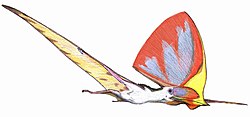| Alanqids Temporal range: Cenomanian-Coniacian, | |
|---|---|
 | |
| Holotype jaws of Alanqa | |
| Scientific classification | |
| Kingdom: | Animalia |
| Phylum: | Chordata |
| Class: | Reptilia |
| Order: | † Pterosauria |
| Suborder: | † Pterodactyloidea |
| Clade: | † Azhdarchoidea |
| Clade: | † Azhdarchiformes |
| Family: | † Alanqidae Pêgas et al., 2022 |
| Genera | |
| |
Alanqidae is a group of azhdarchoid pterosaurs from the Late Cretaceous of North Africa and South America. It is defined as all pterosaurs more closely related to Alanqa saharica than to Chaoyangopterus zhangi (a chaoyangopterid) or Azhdarcho lancicollis (an azhdarchid).













